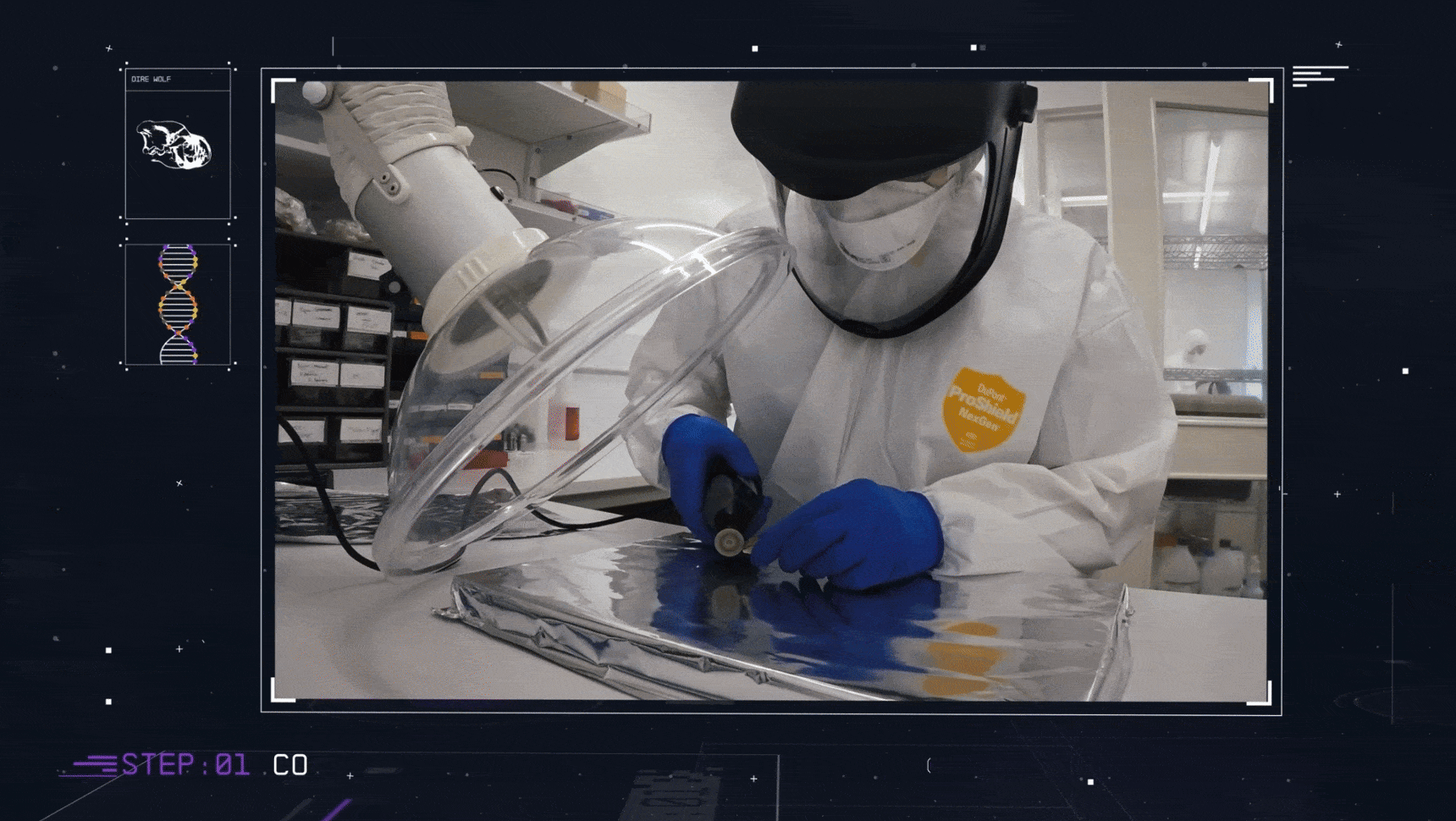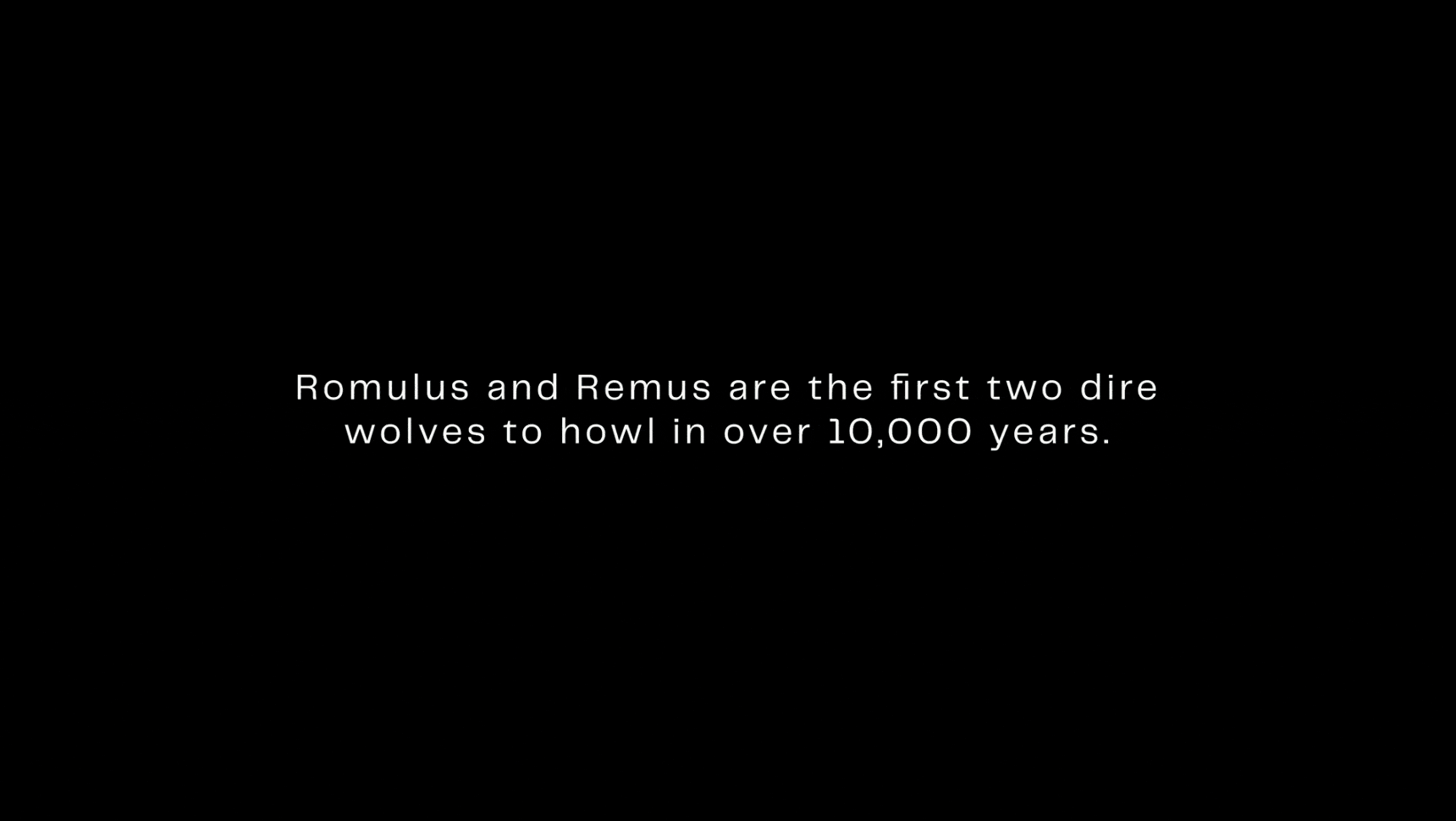
It was managed like a top-secret operation.
Programmed in a biosciences laboratory under strict secrecy…
Resurrected using genetic editing technology…
Implanted into a surrogate dog…
And born last October, Romulus and Remus were only revealed to the world when they turned six months old.

Dire Wolves | Colossal
The picture above might not appear to be out of the ordinary, but it is.
Above are two dire wolves – a species that has been extinct for more than 10,000 years.
And yet, here they are, already 4 feet long and 80 pounds… and likely to grow to 6 feet long and 150 pounds before the end of this year.
Romulus and Remus are roaming on a private and secure preserve, being closely monitored by 10 full-time care staff.
Not only is the de-extinction of a species a remarkable event, but editing a germline is still an experiment.
Those edits could potentially cause unforeseen health issues in the dire wolves… or result in traits that might be uncharacteristic or even dangerous…
Which is why the preserve is surrounded by a 10-foot-tall, zoo-grade fence.
The secrecy of the dire wolves project by Colossal Laboratories & Biosciences, and the way the company chose to reveal it to the public, created quite a bit of consternation and controversy in the scientific community.
With all the outrage, one would have thought Colossal had done something much worse.
“It’s not a dire wolf. It’s misleading to call it that,” said Vincent Lynch, an evolutionary biologist at the University at Buffalo. “I can’t explain how pissed off it made me, because they’re still saying this stuff, and they know it to not be true.”
David Shiffman went further on a semantics rant and said flat out:
This is not a dire wolf by any reasonable definition of a dire wolf… This is a gray wolf that has had a tiny fraction of its genes modified to look more like what they think a dire wolf looked like. That means these animals are still gray wolves.
Here’s Ben Novak, a scientist at a de-extinction non-profit, who had his feelings hurt…
The announcement of the dire wolves has broken with the tradition of everything else that Colossal and others have been doing in this field […] You don’t announce a de-extinct animal when it’s 6 months old. You announce a project when you start it. It doesn’t really feel good to me.
It was a wild string of events that led to the outrage.
Colossal did in fact de-extinct, or bring back to life, dire wolves using genetic editing technology.
The secrecy of the project was interesting. As per the comments above, it is typical to publish and share this kind of research openly in the academic community. But the critics seem to have forgotten that Colossal is a for-profit, private company.
Colossal raised $200 million – its largest round to date – in its Series C funding round finalized this January. It’s clear that investors in that round had insider knowledge of the incredible progress Colossal had made with the dire wolves prior to their investment. I’d be shocked if they hadn’t been allowed a site visit to see the dire wolves in real life in their environment at their secret preserve.
And it must have been impressive. The Series C round wasn’t just any round. Colossal’s previous financing in July of 2024 put the company at a $1.4 billion pre-money valuation. The Series C resulted in a $10.2 billion post-money valuation, almost a 10X in about six months. Incredible.
The choice of dire wolves as a species to bring back to life was an interesting one, too.
Scientifically, Colossal had high-quality DNA samples from a 13,000-year-old tooth and a 72,000-year-old skull, shown being extracted from the short video below.

Retrieving Dire Wolf DNA Samples | Source: Colossal
The team at Colossal was able to generate whole-genome sequences from each sample. With that information, they determined that genetically, the dire wolf was closest to the gray wolf.
Dire wolves were comparable in size to the largest gray wolves but had larger temporalis muscles, resulting in a fiercer bite.
By comparing the differences between the genomes of the dire wolf’s DNA and the gray wolves, the scientists were able to determine the most relevant genetic sequences that were believed to make a dire wolf a dire wolf.
Genetic edits were then made to 14 gray wolf genes to transform them into dire wolves.
This is referred to as multiplex gene editing, something that is really bleeding edge in the field.

LCORL Gene in Dire and Grey Wolves | Source: Colossal
It’s worth mentioning that the dire wolves also had something else going for them: a hype factor, as they’re somewhat of a mythical creature reintroduced to society in The Game of Thrones. Now, they’re alive and not just an incantation on HBO.
If that weren’t enough, there were three litters of dire wolves, which also include an appropriately named female puppy – Khaleesi (from Game of Thrones).
Colossal was clearly going for major public relations with regards to the launch of its secretive project, and it definitely got it.
In April 2025, The New Yorker – which I might add is a bizarre choice for a publisher for a story like this – broke its embargo and published the story ahead of the agreed-upon schedule. It titled the piece, “The Dire Wolf Is Back,” which stirred things up in the industry.
And then Time published quickly with the following cover story. Who would have thought genetic editing would have gone so mainstream?

Source: Time
In many ways, it’s a shame.
Editas Medicine (EDIT) got no mainstream media coverage when it successfully restored partial sight with a single injection into the eye for a variant of LCA-10 – a form of blindness caused by a single genetic mutation.
Or how about when CRISPR Therapeutics successfully developed a now FDA-approved genetic therapy for sickle cell anemia and beta thalassemia?
It seems the mainstream media is more drawn to a mystical creature from Game of Thrones and a puppy named Khaleesi than it is to the underlying breakthrough of CRISPR genetic editing technology – invented and patented by Editas Medicine (EDIT).
It’s hard not to be inspired by the pictures, though.
After all, Colossal brought many traits of a dire wolf back to life, literally. The scientists who felt left out because of all the secrecy can argue over semantics…
But what Colossal did is still extraordinary.

Romulus and Remus | Source: Colossal
I last wrote about Colossal this March in The Bleeding Edge – A Woolly What?, when Colossal successfully edited woolly mammoth traits into two mice.

Source: Colossal
It may have looked like a parlor trick at the time, but it was clearly a sign of things to come.
Colossal was caught off guard by the early release of the story by The New Yorker. It happened before Colossal published its research on its dire wolves project where it clearly laid out its methods used to achieve the de-extinction.
And it was also forthcoming that it did not duplicate – base pair by base pair – the dire wolf DNA that had been recovered. For anyone interested, you can find the research on dire wolves here.
While Colossal continues to try to frame itself as the de-extinction company with lots of language about restoring the natural balance to the environment by reintroducing extinct species to the planet, that’s not its business.
And the bigger story is its real business…
Colossal has successfully demonstrated very complex germline editing on animals. It has successfully edited DNA to produce the expected traits that result from specific sequences of DNA.
And I’m going to say the quiet part out loud…
This same technology can also be used for humans. To make us stronger, smarter, have denser muscle tissue, have more focus, be void of any unwanted genetic mutations, make us resilient to forms of disease, etc.
Do we think it’s impossible?
Definitely not. It has already happened.
He Jiankui, a Chinese scientist, conducted germline editing on embryos from parents who had HIV. He edited the DNA of the embryos to be resistant to HIV in a scientific experiment to see if the offspring could be protected from the disease. And while it appears to have worked, he crossed a line and served three years in prison for it.
So is it that much of a stretch to imagine – now that we have this incredible technology that we know works – that certain governments, using funding from NGOs, in private labs in countries with lax oversight, might be working with this technology? And that they might be trying to make “better, faster, stronger, smarter” scientists, athletes, and soldiers?
And worth noting is that Colossal has also developed artificial womb technology for incubating and growing the technology, which will almost certainly be spun out into a new company.
Of course, there are immediate implications for animal husbandry… but again, is it that much of a stretch to imagine that the end game isn’t artificial wombs for humans?
Colossal has already spun out two companies: Form Bio, as a computational biology company, and Breaking, which is using genetic editing to create synthetic substances that can degrade plastics.
These technologies that Colossal has been developing under the hood have nothing to do with de-extinction…
But they have incredible implications for the future of genetic editing and what’s to come.
Jeff
The Bleeding Edge is the only free newsletter that delivers daily insights and information from the high-tech world as well as topics and trends relevant to investments.
The Bleeding Edge is the only free newsletter that delivers daily insights and information from the high-tech world as well as topics and trends relevant to investments.